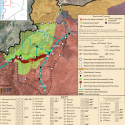 |
 |
Turkey Reinforces Positions in Greater Idlib to Pressure Russia into Negotiations

By: Andrew Greco
Key Takeaway: Events since ISW assessed that Turkey and Russia may have reached a deal on September 16 indicate negotiations faltered. Turkish forces are reinforcing their military positions in opposition-held Idlib as means of exerting pressure on Russia in order to obtain a favorable negotiated settlement. Turkey and Russia will likely continue to escalate while avoiding direct military confrontation in an attempt to gain leverage in future negotiations.
The Turkish Armed Forces (TSK) continued to deploy to greater Idlib Province between April 1 and October 7, 2020, despite Turkey striking a de-escalation deal with Russia on March 5, 2020. The TSK has roughly a division—over 20,000 servicemen—deployed to Idlib across 67 military positions as of October 7; Turkey only maintained 61 military positions as of April 1. Recent deployments include experienced mechanized infantry, armor, and artillery units likely intended to act as a deterrent to an Assad regime offensive. New Turkish deployments have been concentrated south of the M4 highway in the Sahl al-Ghab, Jabal Zawiya, and Jisr al-Shughour regions—the likeliest targets of a pro-regime offensive. These new deployments have likely resulted in higher overall troop levels, even after Turkey withdrew “hundreds” of TSK and proxy forces on September 8 and continued to deploy Syrian fighters to Libya and Azerbaijan.[1]
ISW assessed on September 18 that Russia and Turkey may have reached an agreement permitting a renewed regime offensive in negotiations on September 16.[2] Subsequent events indicate that Russia and Turkey did not arrive at a settlement and are now trying to pressure one another to force a resumption of negotiations on favorable terms. While Russian and regime forces have engaged in limited kinetic escalation along the southern Idlib front lines to pressure Turkey, Turkey has reinforced its military positions with the TSK and proxies to pressure Russia. The TSK deployed additional armor units to its bases near Ariha on September 22.[3] Seven TSK convoys totaling at least 160 military vehicles reinforced various Turkish positions near Ariha and Jisr al-Shughour on October 3 and 4; Turkish resupply convoys typically do not exceed 30 vehicles.[4] The Turkish-backed Syrian National Army also reinforced its positions and reportedly “increased its combat readiness” in Jabal Zawiya on October 3 and 4.[5] A pro-regime offensive without negotiated permission from Turkey would likely be costly for both sides, given the significant artillery and armor deployed.
This map updates the ISW map published on March 31.[6] It provides an assessment of the locations of Turkish military positions in greater Idlib and the unit types deployed to each location based on publicly available information.
Click here to expand the image.

[1] https://www dot 7al dot net/2020/09/08/%d8%aa%d8%b1%d9%83%d9%8a%d8%a7-%d8%aa%d8%a8%d8%af%d8%a3-%d8%a8%d8%a5%d8%ac%d9%84%d8%a7%d8%a1-%d8%ac%d9%86%d9%88%d8%af%d9%87%d8%a7-%d9%85%d9%86-%d8%ac%d9%86%d9%88%d8%a8%d9%8a-%d8%a5%d8%af%d9%84%d8%a8/
[2] http://www.understandingwar.org/backgrounder/syria-warning-update-syrian-regime-offensive-idlib-may-be-imminent
[3] http://www dot Syria dot tv/%D8%A8%D8%A7%D9%84%D8%AF%D8%A8%D9%91%D8%A7%D8%A8%D8%A7%D8%AA-%D8%A7%D9%84%D8%AC%D9%8A%D8%B4-%D8%A7%D9%84%D8%AA%D8%B1%D9%83%D9%8A-%D9%8A%D8%B9%D8%B2%D9%91%D8%B2-%D9%82%D9%88%D8%A7%D8%B9%D8%AF%D9%87-%D9%81%D9%8A-%D8%AC%D8%A8%D9%84-%D8%A7%D9%84%D8%B2%D8%A7%D9%88%D9%8A%D8%A9
[4] https://www.syriahr.com/en/186876/
[5] https://www.syriahr.com/en/186893/ ; https://www dot radioalkul dot com/p344716/ ; http://www dot syria dot tv/%D8%AA%D8%B9%D8%B2%D9%8A%D8%B2%D8%A7%D8%AA-%D9%83%D8%A8%D9%8A%D8%B1%D8%A9-%D9%84%D9%84%D8%AC%D9%8A%D8%B4-%D8%A7%D9%84%D9%88%D8%B7%D9%86%D9%8A-%D9%86%D8%AD%D9%88-%D8%AC%D8%A8%D9%87%D8%A7%D8%AA-%D8%A5%D8%AF%D9%84%D8%A8-%D8%B5%D9%88%D8%B1
[6] http://www.iswresearch.org/2020/03/turkeys-military-buildup-in-syrias.html